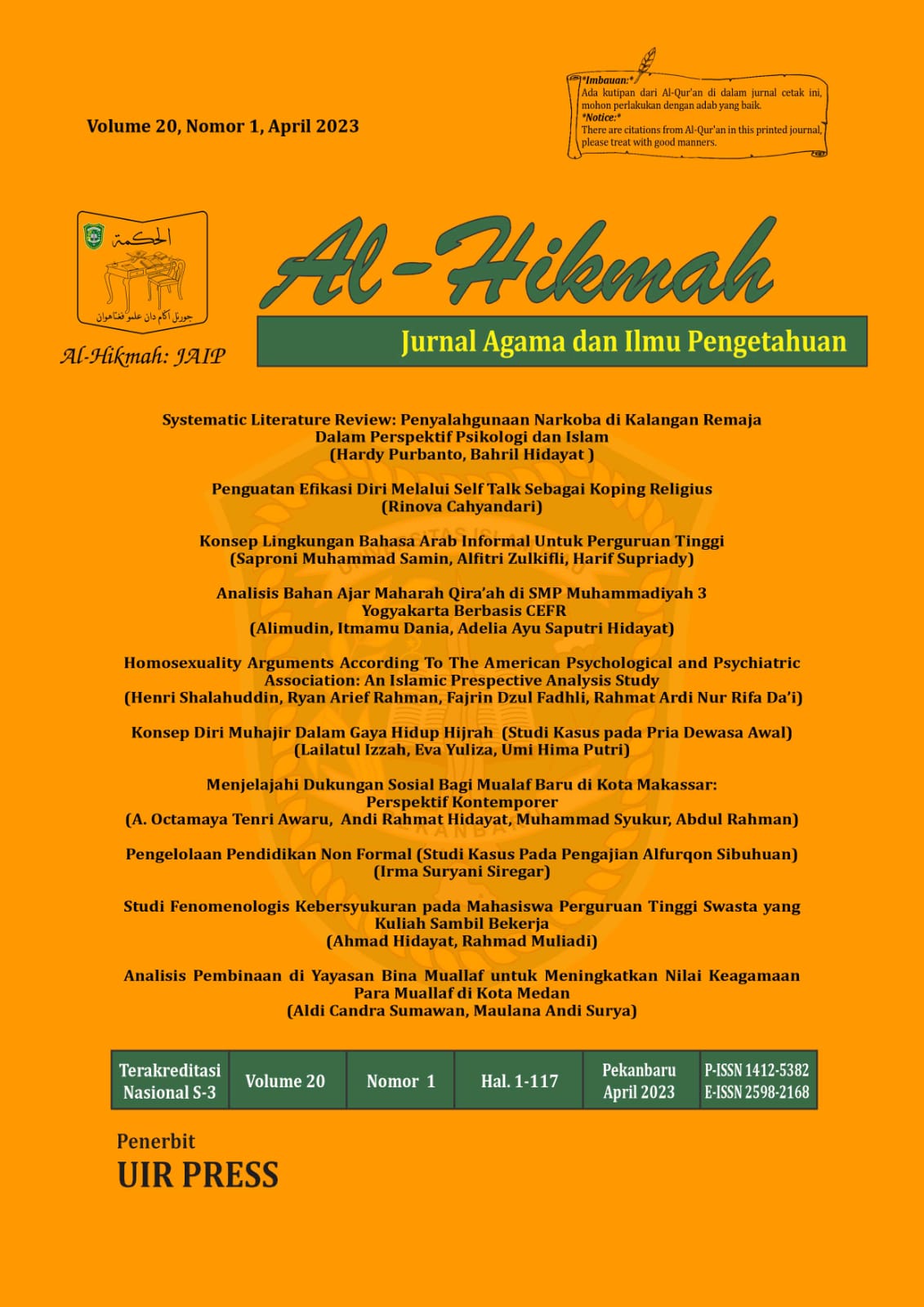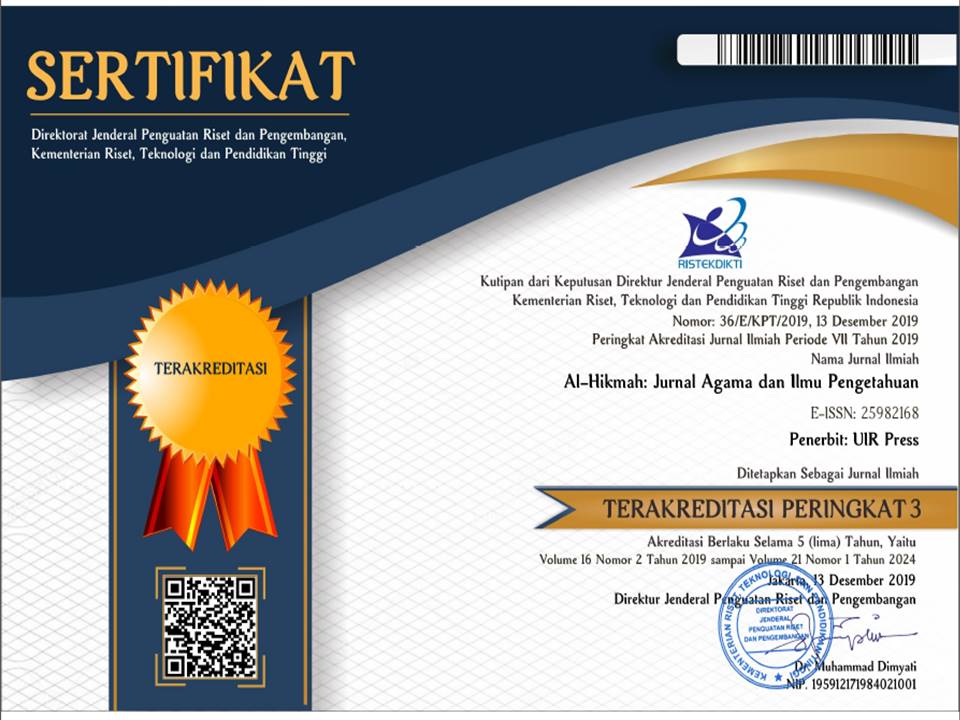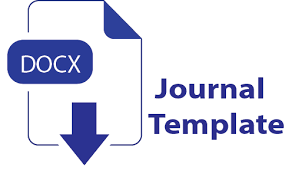Konsep Lingkungan Bahasa Arab Informal Untuk Perguruan Tinggi
DOI:
https://doi.org/10.25299/al-hikmah:jaip.2023.vol20(1).12026Keywords:
Informal Environment, Arabic, ConceptAbstract
Informal language learning outside the classroom plays an important and growing role in language learning and teaching. This research is qualitative research with a library research model. This study aims to determine the concept of an informal Arabic language environment for tertiary institutions and theoretical analysis of the substance to be measured, thus determining the conceptual definition. The steps taken in data collection refer to the actions specified by Thomas Mann with seven steps. The research data analysis uses 3 keywords; student autonomy, the era of disruption, and language communication. This study concludes that the Informal language environment has several characteristics and aspects. These elements, as well as aspects, are 1) Social and cultural contacts; 2) Virtual Learning and Website Proliferation; 3) support from teachers; 4) Learning language with Emotions is not just cognition; and 5) Institutional responsibility in the form of policies.
Downloads
References
Alharbi, N. S. (2022). The Effect of Virtual Classes on Promoting Saudi EFL Students’ Autonomous Learning. Journal of Language Teaching and Research, 13(5), 1115–1124. https://doi.org/10.17507/jltr.1305.26
Ali, Y., Al-Nahdi, A., & Zhao, S. (2022). A new decade for social changes Learning Arabic language in China: Investigation on instrumental and integrative motivations of Chinese Arabic learners. 27. www.techniumscience.com
Attiyat, N. M. A., Abu-Snoubar, T. K., Al-Shboul, Y., & Ismael, M. M. H. (2022). COVID-19 Outbreak, State of a Questionable Dilemma, or a Learning Escape: Second Language Acquisition Within Virtual Learning and Social Contact. Theory and Practice in Language Studies, 12(6), 1098–1106. https://doi.org/10.17507/tpls.1206.09
Ayieko, G., & Mwangi, P. (2022). Role of Social Networks, Attidude, and Motivation in Informal Foreign Language Learning: A Case Study of the Tourism Industry in Mombasa County, Kenya. Journal of Communication and Cultural Trends, 4(1). https://doi.org/10.32350/jcct.41.02
Azzolini, D., Campregher, S., & Madia, J. E. (2020). Formal instruction vs informal exposure. What matters more for teenagers’ acquisition of English as a second language? Research Papers in Education, 1–29. https://doi.org/10.1080/02671522.2020.1789718
Bensid, H., Habbaz, H., & Hiouani, A. S. (2022). Students’ attitudes towards formal and informal ways of leaning vocabulary.
Benson, P. (2022). Mapping language learning environments. In The Routledge Handbook of Language Learning and Teaching Beyond the Classroom (pp. 24–35). Routledge.
Betancor-Falcon, S. (2022). A Critical History of Autonomous Language Learning: Exposing the Institutional and Structural Resistance Against Methodological Innovation in Language Education. SiSal Journal, 13(3), 332–346. https://doi.org/10.37237/130303
Byrd, D., & Abrams, Z. (2022). Applying Positive Psychology to the L2 Classroom: Acknowledging and Fostering Emotions in L2 Writing. Frontiers in Psychology, 13. https://doi.org/10.3389/fpsyg.2022.925130
Carlos, J., & López, A. (2022). Informal English learning activity systems mediated by online resources: a case study on the perception of affordances by FL teachers in training at UNAD.
Dewaele Chengchen Li, J.-M. (2020). Emotions in Second Language Acquisition: a critical review and research agenda. Foreign Language World, 196(1).
Dressman, M., & Sadler, R. W. (2020). The handbook of informal language learning. John Wiley & Sons.
Effendi, A. F. (2017). Metodologi Pengajaran Bahasa Arab (7th ed.).
Febriani, S. R., Wargadinata, W., Syuhadak, S., & Ibrahim, F. M. A. (2020). Design of Arabic Learning for Senior High School in the 21st Century. Jurnal Al-Bayan: Jurnal Jurusan Pendidikan Bahasa Arab, 12(1), 1–21. https://doi.org/10.24042/albayan.v12i1.5886
Gallego-Arrufat, V.-M., & Moya, M.-J. (2016). Impact of electronic portfolios on prospective teachers’ participation, motivation and autonomous learning. In Journal of Information Technology Educa-tion: Research (Vol. 15). http://www.informingscience.org/Publications/3575
Ghani, M. T. A., Hamzah, M., Daud, W. A. A. W., & Romli, T. R. M. (2022). The Impact of Mobile Digital Game in Learning Arabic Language at Tertiary Level. Contemporary Educational Technology, 14(1). https://doi.org/10.30935/cedtech/11480
Hamdany, H. Al, & Picard, M. (2022). Literature Circles Enhancing Cultural Awareness and Language Acquisition for Adult Learners of Arabic. International Journal of Society, Culture and Language, 10(3), 89–102. https://doi.org/10.22034/ijscl.2022.550377.2578
Han, Y., & Reinhardt, J. (2022). Autonomy in the Digital Wilds: Agency, Competence, and Self‐efficacy in the Development of L2 Digital Identities. TESOL Quarterly.
Johnsi Priya, J. (2022). Crossover learning for formal and informal learning. PSYCHO-TECHNOLOGICAL APPROACHES IN HEUTAGOGY, 121.
Kerras, N., & Essayahi, M. L. B. (2022). Education and COVID-19: Learning Arabic Language and Perspectives The Electronic Journal of e-Learning. 20(1), 36–52. www.ejel.org
Liu, Z., Hua, J., & Zhang, Z. (2022). Scaffolding Instruction in Virtual Language Learning. Journal of Language Teaching and Research, 13(2), 386–391.
Mann, T. (2015). The Oxford guide to library research. Oxford University Press.
Masfufah, D. (2021). Pengaruh Lingkungan Bahasa Arab Terhadap Penguasaan Mufrodat Bahasa Arab Bagi Siswa MTs Kelas VIII di Pondok Pesantren Teknologi Riau.
Mohamed, Y., Muhamad Saad, D., Ismail, D., Hoque, M., & Lecturer, S. (2022). STUDENTS’ PERCEPTION OF ARABIC ONLINE LEARNING AND ITS RELATIONSHIP IN IMPROVING COMMUNICATION SKILLS. In Journal of Positive School Psychology (Vol. 2022, Issue 2). http://journalppw.com
Monika, M., & Anitha Devi, V. (2022). A Systematic Review on the Effectiveness of Metacognitive Strategies and Multimodal Tools in Blended Learning English Language Classroom. Theory and Practice in Language Studies, 12(11), 2239–2252. https://doi.org/10.17507/tpls.1211.03
Nguyen, C. T., Nguyen, K. T., Pham, H. N., & Le, D. T. K. (2022). Developing EFL Learners’ Autonomy in Speaking English: An Investigation Into Teachers’ Support at a University in the Mekong Delta. Journal of Language Teaching and Research, 13(5), 944–955. https://doi.org/10.17507/jltr.1305.06
Permana, A. (2022, April 1). Karakter yang Dibutuhkan Mahasiswa untuk Menghadapi Revolusi 4.0 - Institut Teknologi Bandung. https://www.itb.ac.id/news/read/58533/home/karakter-yang-dibutuhkan-mahasiswa-untuk-menghadapi-revolusi-40
Pires, F., Masanet, M.-J., Tomasena, J. M., & Scolari, C. A. (2022). Learning with YouTube: Beyond formal and informal through new actors, strategies and affordances. Convergence, 28(3), 838–853. https://doi.org/10.1177/13548565211020545
Rahman, A. (2021). PERAN LINGKUNGAN BAHASA ARAB DALAM MENINGKATKAN PENGUASAAN BAHASA ARAB PADA PESANTREN IZZUR RISALAH PANYABUNGAN.
Razem, R. J., & Pandor, J. (2023). The Motivational Orientations of Undergraduate Students to Learn Arabic in a Dubai Private University. Journal of Language Teaching and Research, 14(1), 96–107. https://doi.org/10.17507/jltr.1401.11
Samin, S. M. (2019a). Heutagogy in Arabic Class: How It Is Applied in The Islamic Education Study Program of Universitas Islam Riau. Journal of Arabic Linguistics and Education, 5(1), 20–29.
Samin, S. M. (2019b). KEMANDIRIAN BELAJAR BAGI PEMBELAJAR BAHASA ARAB DI TINGKAT PERGURUAN TINGGI DI ERA 4.0. Prosiding Pertemuan Ilmiah Internasional Bahasa Arab, 613–618. https://doi.org/10.5281/ZENODO.5630269
Samin, S. M., Akzam, I., & Supriady, H. (2022). Strategies of Arabic Students’ Self-Regulated Learning Improvement in Language Proficiency in The Disruption Era. Jurnal Pendidikan Bahasa Arab Dan Kebahasaaraban, 9(2), 165–177. https://doi.org/10.15408/a.v9i2.22828
Samin, S. M., & Hikmah, H. (2021). SELF-REGULATED LEARNING OF ARABIC EDUCATION STUDENTS VIA MOODLE DISCUSSION FORUM. Journal of Arabic Linguistics and Education, 7(1), 17–29. https://tinyurl.com/yyms4ts9.
Samin, S. M., Pebrian, R., & Zulkifli, A. (2020). Heutagogy Approaches for Arabic Learning in Higher Education in Industrial Revolution 4.0. ICoSEEH 2019, 454–457. https://doi.org/10.5220/0009382304540457
Samin, S. M., Yunita, Y., & Akzam, I. (2021). Strategi Peningkatan Kemandirian Belajar Mahasiswa Pendidikan Bahasa Arab di Era Revolusi Industri 4.0. Perspektif Pendidikan Dan Keguruan, 12(2), 113–120.
Shelton-Strong, S. J. (2022). Advising in language learning and the support of learners’ basic psychological needs: A self-determination theory perspective. Language Teaching Research, 26(5), 963–985. https://doi.org/10.1177/1362168820912355
Unsi, B. T. (2021). Pengaruh Lingkungan Bahasa terhadap kemampuan Berbicara Bahasa Arab. Tafáqquh: Jurnal Penelitian Dan Kajian Keislaman, 9(1), 99–114.
Usoz Zabaleta, P. (2022). Informal exposure, motivation and lexical diversity in young EFL learners.
Uztosun, M. S. (2021). Foreign language speaking competence and self-regulated speaking motivation. Foreign Language Annals, 54(2), 410–428. https://doi.org/10.1111/flan.12559
VanPatten, Bill., & Williams, J. (2007). Theories in second language acquisition : an introduction. Lawrence Erlbaum Associates.
Yu, L. T. (2023). A Comparison of the Autonomous Use of Technology for Language Learning for EFL University Students of Different Proficiency Levels. Sustainability (Switzerland), 15(1). https://doi.org/10.3390/su15010606
Zhang, R., & Zou, D. (2022). Self-regulated second language learning: a review of types and benefits of strategies, modes of teacher support, and pedagogical implications. Computer Assisted Language Learning, 1–38. https://doi.org/10.1080/09588221.2022.2055081






